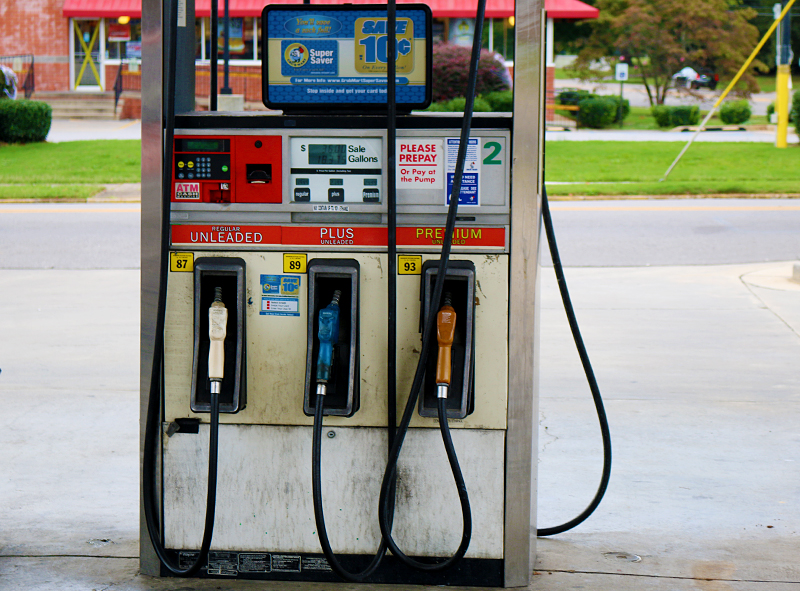A friend of mind sent information to me via e-mail message within the past couple of hours alerting me to a “great safety tip for cars” in the form of this article written by Charis Brown for consumer advocate Clark Howard — and knowledge of safety and compliance has been a part of his job description over the years since his employment at Delta Air Lines and subsequently at other reputable large companies.
Three Reasons Why You Should Not Top Off the Fuel Tank of Your Car
There are three reasons why you should not top off the fuel tank of your car — one of them which includes the following safety tip:
…topping off tha (stet) tank can result in a greater chance that gas is spilled onto the ground, and these gasoline spills can contribute to bad ozone days as determined by the Air Quality Index.
If you happen to damage your car’s vapor recovery system by topping off your tank, it also won’t be able to protect people and the environment from harmful vapors caused by improperly processed gasoline.
You Pay for Gasoline You Do Not Get?
I found the following paragraphs interesting as another reason why you should not top off the fuel tank of your car:
According to the EPA, once a gas tank is full, there is no way to fit any more gas in the tank. Gas stations are equipped with a vapor recovery system so that if a tank is full, the pump will pull the extra gas you’re trying to pump into your car back into the station’s tanks. This is a safety precaution to ensure excess vapors will not escape into the environment.
So, even though you are paying for more gas, if your tank is full, the excess will go right back to the station anyway!
I can honestly say that I did not know that. I do tend to top off the gasoline tank in cars; and my experience suggests to me that I do indeed get more gasoline into the car…
…but if the extra gasoline does indeed return to the fuel pump of the service station, does that fuel get sold again? Should there not be an indicator that the extra gasoline being pumped for which you are paying will not be used by you?
Damage to the Carbon Filter Vapor Collection System?
I have never had a repair required to fix the carbon filter vapor collection system; and possible damage to the carbon filter vapor collection system is considered to be the third reason why you should not top off the fuel tank in a car.
The Official Position of the Environmental Protection Agency
I am not questioning the veracity of the statements; but there was no link provided to the official Internet web site of the Environmental Protection Agency of the United States to support those statements — so I searched for it and found numerous articles which essentially contained the same verbiage, bordering on plagiarism in some cases…
…so I then went to the official Internet web site of the Environmental Protection Agency and searched; and lo and behold, there is this article written by Catherine Magliocchetti, who on Monday, July 26, 1999 — the time that the article was released — was a chemical engineer of the federal agency.
Here is an excerpt from that article on why “topping off is a loser three ways” and how you can save approximately $20.00 per year, depending on the price per gallon of gasoline:
First, you lose money when you top off because you pay for gasoline that you don’t get. When the gas pump automatically shuts off, a vapor lock blocks more gas from entering your car. After the tank is full, the gas you pump gets sucked back through an outer “vapor-return” hose into the station’s underground storage tank. The meter may be running, but your not getting the gas.
Secondly, you personally pollute the air because topping off clogs the vapor-return hose with liquid gasoline, so it can no longer return excess vapors. It works on the same principle as the water-filled trap on your kitchen sink, except at the pump, you want gasoline vapors to float back down the hose, not get stopped by a liquid-filled trap that you created by topping off.
Even worse, once you plug up the vapor-return hose, it stays plugged up until someone clears it by lifting it overhead to drain all the liquid back into the underground storage tank.
And thirdly, a gasoline-filled vapor-return pretty much guarantees that you and everyone after you will be breathing in a cloud of volatile gasoline molecules — invisible but harmful — while you pump gas. Excess molecules under pressure can’t float back down the return hose, so they get forced out around the nozzle and into the air. That’s when you smell gas.
As you stand there filling your tank, you’re getting exposed to some nasty chemicals — including benzene, toluene and 1,3-butadiene — that injure your lungs and can even cause cancer over time. As a general rule, if you can smell the gasoline when you’re pumping it, the vapor-return system isn’t working properly, and you should let the attendant know it needs to be serviced.
The cited information was reinforced on Wednesday, July 28, 2004 by this updated article from the Environmental Protection Agency.
Skepticism
“There is little in this article that is factual.” That statement was posted by Reddit member RigobertaMenchu.
“Having worked at a car rental place where i would tank up to 40 ish cars a day I can confirm this”, Reddit member javice confirmed in response to the statement that the gasoline pump is not filling every last space in the fuel tank and will have plenty of room for expansion. “It has been a while, but I always tried to see how much more I could fill in after the pump stopped, I dont remember the numbers but it was way over a liter.”
Those are two of many skeptical statements posted in that discussion alone — not that that means that they are correct.
Summary
From this point on, I will think twice before I top off the fuel tank in a car — but as I said, my experience suggests to me that I do indeed get more gasoline into the car…
…and topping off the fuel tank in a rental car could be a catalyst as to what led to the creation of an Express Fuel Option at many rental car companies. Fill that tank with gasoline and top it off as much as possible; then drive the car as far as possible while still keeping the fuel gauge showing that the tank is full. There have been times where I have topped off the fuel tank in a rental car and drove approximately 75 miles or so without the needle budging from its extreme position on the fuel gauge — and no, this was not to return the car to the rental car facility; but rather preparation for a long drive so that I would not need to stop for refueling the fuel tank on the way to where I was going.
To reiterate, the purported reasons as to why you should not top off the fuel tank in your car — especially as the price of gasoline is less than $1.30 per gallon in some locations around the United States — include:
- Possible damage to the carbon filter vapor collection system
- Potentially harming the environment with pollution caused by vapors and accidental gasoline spills
- Wasting money on gasoline which supposedly returns to the fuel pump of the service station as opposed to going into the fuel tank of your vehicle
Photograph ©2015 by Brian Cohen.

